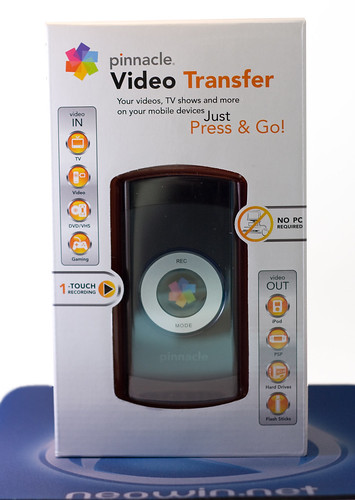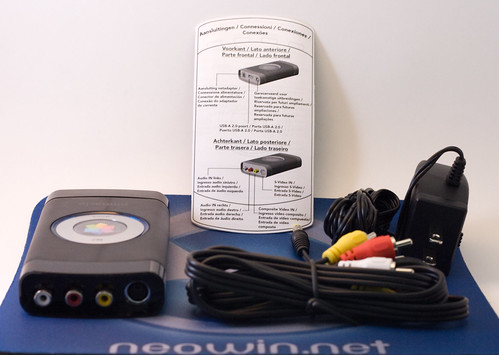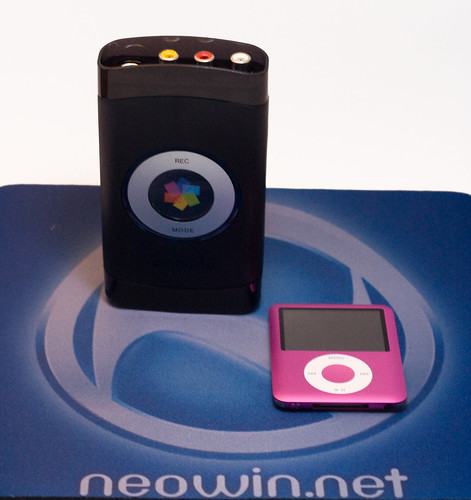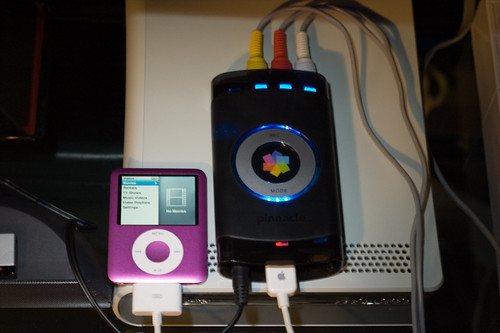Ever wanted to record a video stream without lugging a computer around? The Pinnacle Video Transfer allows you to do just that! All you need is an S-Video or composite source, and a USB based storage device. With just a few clicks, you can record your analog source to MPEG-4 at up to 720x480/576 (NTSC/PAL) resolutions. Check in on how the Pinnacle Video Transfer stood up to our tests!
Box Contents
- Pinnacle Video Transfer main unit
- Power adapter
- Composite video cables


First Impressions
When you take out the Pinnacle Video Transfer device, you can see how simple it is meant to be. There are only two buttons on it: Quality Mode and Record. With such few options, you can be up and recording in under a minute.
Usage
My first thought after reading the description and uses for the Pinnacle Video Transfer was that it would be great for recording game play from my Xbox 360 or my Wii. With such a simple device, I already hit my first snag. As you can see in the photos, there is a composite input, but it lacks any output. From Pinnacle's website, the Video Transfer can deliver "One-touch start/stop recording from any video source including a TV, DVD player, PVR, camcorder, set-top box or gaming console." Clearly above all else, gaming consoles are hit the biggest with this, since you cannot see what you are doing while recording. If you plan to record just an automated replay of something you already did, that should work fine, just you still will not know when the replay is over.
Even given the above issue, I was still determined to record game play from my Wii. I borrowed my mom's iPod Nano (hence the pink!) to test not only the recording ability, but also immediate playback on the device. At this point, I hit snag number two. One of the few steps in recording video is simply waiting for all lights to turn blue. The USB connection remained blinking red. I tried a flash drive I had handy, and that also would not settle to ready status. After attempting with two other flash drives, finally one worked. It is actually one of my older flash drives, and the smallest. I loaded Mario Kart while the Wii was hooked through my TV, and then once I got in a game, hooked the cables up to the Pinnacle Video Transfer. I was able to record at the highest setting, but I had to drive blind. The only idea I had of what was going on was what the Wii controller gave me with a few random noises and vibration.
I loaded the video onto my laptop, and found it to be fairly reasonable quality; especially since no computer was needed. One minute and 45 seconds weighed in around 21MB. Since it is just a composite source, you probably couldn't make the quality too much better using a computer to record.
Pros
- Small, simple setup
- Easy, straightforward recording options
- Good quality recordings
Cons
- No line out to see the source video being recorded
- Picky about the storage device
- Only fat16 or fat32 file systems supported
Final Roundup
The Pinnacle Video Transfer device delivers quite decent direct-to-storage recording, but at the cost of important functionality. It seems they made it too simple to be as useful as it could be. The idea is great, but the execution of this device isn't where it should have been. It is a fairly small device, but it isn't tiny, and it could have added some sort of output so you could see what you are recording. Unfortunately this just has too many downfalls to make it as usable as it could be. Hopefully Pinnacle will create an updated version with a few more options, and perhaps a firmware update can fix the storage device issues. As much potential as this has, I can only give it a 2 out of 5 rating.
![]() Video: Mario Kart Wii on high quality setting (21mb, mp4)
Video: Mario Kart Wii on high quality setting (21mb, mp4)![]() Link: Pinnacle Video Transfer (MSRP $99)
Link: Pinnacle Video Transfer (MSRP $99)
More Photos
To see all photos and higher resolutions, visit this collection


















6 Comments - Add comment